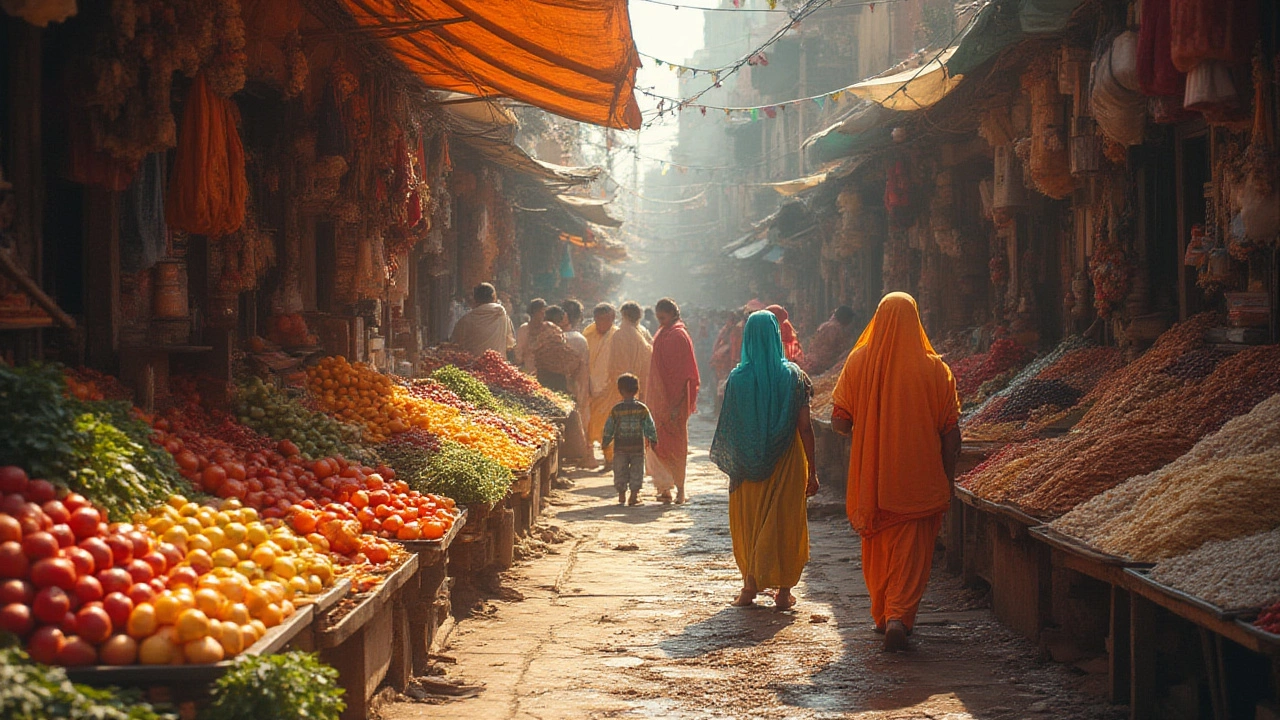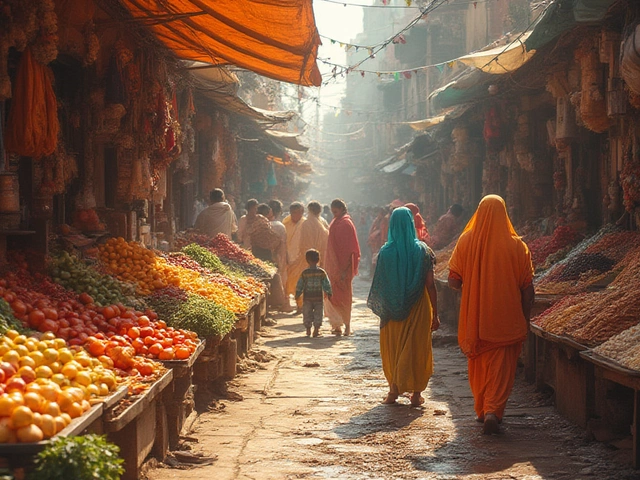If you walk through a busy street market in Delhi or scroll through your social feed during an online sale, the question just jumps out: what’s actually selling the most in India? The answer isn’t what most outsiders expect. Forget gold or the latest smartphone. The real giants of the Indian market are humble, everyday items—think biscuits, soft drinks, soaps, and increasingly, affordable smartphones. It’s not a matter of hype, it’s a story written by a billion wallets deciding every day what their rupees will buy next.
The Reigning Champions: What Actually Tops Sales Charts?
Picture this: a country with 1.4 billion people, each with their own priorities. What's at the top of shopping lists? Staples. It’s not flashy, but food rules here. Parle-G, that brick-shaped glucose biscuit, is a real winner. In 2022, Parle-G posted unbelievable numbers—over 400 million packets sold every month, according to Nielsen India. That’s enough to circle the earth several times if you lined up every biscuit. The same kind of dominance is true for Maggi instant noodles, a kitchen essential in many Indian homes. Beyond biscuits, the cola wars still rage, with Coca-Cola and Pepsi squaring off in every city, and their drinks reaching remote villages carried in steel crates on motorcycles.
But what sells best in India isn’t only measured by supermarket shelves. Jio—yes, Reliance’s telecom powerhouse—is worth mentioning. Their super-cheap mobile phones, especially during their JioPhone launch, changed how India connects and shops. According to the Telecom Regulatory Authority of India, mobile data consumption skyrocketed after Jio’s entry, and their phones consistently appear among top bestselling devices by volume. When you hit a train station or small town, even grandmothers are flicking through WhatsApp offers on these basic smartphones.
Soap, too, is an unlikely bestseller. Hindustan Unilever’s Lifebuoy sells over a billion bars yearly. With India’s hot and sticky climate plus a rising awareness (boosted by major public health campaigns), hygiene products move fast here. Everybody wants to stay clean, so prices are slashed, and packs grow ever smaller or bigger to suit every budget. There’s even a Hindi phrase—‘ek sabun, har ghar mein’—one soap, in every home.
If you look at the numbers, it’s not phones or even cars at the top—it’s food, drink, and basic hygiene. According to a report by India Brand Equity Foundation in 2023, these FMCG (Fast-Moving Consumer Goods) categories consistently lead volume sales. Take a look at the following quick snapshot:
| Product | Annual Sales (2023) | Top Brand/Producer |
|---|---|---|
| Biscuits (Parle-G) | ~48 billion packets | Parle Products |
| Instant Noodles | ~6 billion servings | Nestlé (Maggi) |
| Soap Bars | ~1.3 billion units | Hindustan Unilever |
| Soft Drinks | ~12 billion bottles/cans | Coca-Cola, PepsiCo |
| JioPhones | ~70 million units | Reliance Jio |
Behind the Numbers: Why These Items Dominate
Okay, so why these products, and not others? India is a land of endless variety—hundreds of languages, faiths, festivals, and pocket sizes. You can’t sell a one-size-fits-all product here. The real champions are those that crack three codes: price, availability, and habit. Biscuits like Parle-G sell for under 10 rupees a pack—less than what a cup of tea costs in most cities. Soft drinks and Maggi fit right into daily routines—after-school snacks, bus stop breaks, post-work recharge.
Brands chase ‘reach’—they want to be in every chai shop, roadside stall, and corner store. Distribution networks in India are wild; the best-selling brands have armies of agents reaching even the most tucked away hamlets. Coca-Cola India, for example, brags about reaching more than two million small stores, known as kiranas. That’s more than any single chain.
Then there’s the emotional angle. Ask any Indian about Parle-G, Maggi, or even Dettol soap, and you might hear a memory attached to childhood, exams, or family rituals. These brands become part of home culture, so parents buy them for their kids, kids grow up to buy them for theirs. Relatability means repeat business. One study from Kantar in 2023 highlighted that 71% of rural shoppers stick to the same five household products month after month.
“Our biggest challenge wasn’t creating a new flavor but making sure our biscuit was on every grocer’s shelf in the country, from the richest city to the smallest village,” said a Parle executive in a
BBC News interview from June 2024.
It’s not just the big cities driving sales. India is still very rural—about 65% of people live outside major towns. This shapes everything. When consumers buy tiny sachets of shampoo or mini biscuit packs, it’s about stretching money, not chasing fad diets or luxury. Companies that adjust to this mindset—offering single-use or very small packs—often win big.

How Modern Trends Are Changing the Most Sold Product List
Now, it isn’t all old favorites anymore. 2025 is showing a shift, even if classics hold strong. Smartphones, as mentioned, are a runaway success. India added more than 150 million new smartphone users between 2020-2024, according to Counterpoint Research. That’s the entire population of Russia, just in new device buyers. Among the top five bestsellers these days, you’ll spot not just JioPhones but also entry-level Xiaomi, Samsung, and Realme models—priced under Rs 10,000 (about $120).
Online shopping is a game changer. Flipkart and Amazon now reach everywhere, including those pin codes traditional shops ignored for years. E-commerce biggies have learned to stock up on what people want: affordable clothing, kitchen gadgets, beauty creams, home essentials. During big sales, like Flipkart’s Big Billion Days in 2024, the top selling item was… not phones, but affordable t-shirts, followed by pressure cookers and inexpensive headphones. It’s always about what’s needed most, at prices the largest chunk of buyers can afford.
The COVID-19 pandemic kicked up hand sanitizer, disinfectants, and digital payment apps into everyday life. While sanitizer sales peaked in 2021-2022, their baseline is now much higher. Paytm, PhonePe, and Google Pay—digital apps—are technically the most ‘used’ things in India after WhatsApp and YouTube, with billions of monthly transactions.
Sustainability is a small but growing trend. Eco-friendly pads, reusable water bottles, and organic snacks still don’t crack mass volume lists, but double-digit growth every year says they might soon enough. If you want to bet on tomorrow’s bestsellers, watch these eco-upstarts and affordable tech accessories.
Most sold products in India always have something in common: they’re reachable, relatable, and repeat buys. Makers constantly tweak packaging, portions, and pricing to match every corner of the country. Tiny shampoo sachets, economy packs of instant coffee, solar-powered lamps—if it fits a need, it sells.
Tips for Spotting and Riding India’s Best-Selling Product Waves
Ready to spot what’s hot and maybe build a business around it? Here are some solid, field-tested ideas:
- Watch Out for Packs and Portions: Success in India means offering the right pack at the right price. Single-use, trial packs sell in rural areas, while mega-packs win in urban family homes. FLEXIBILITY is king.
- Distribution Is More Important Than Advertising Alone: The big brands don’t just shout loud—they get their products everywhere, from dusty highway stops to gleaming supermarkets. If you can’t match their distribution game, even the best product will lag behind.
- Lean on Habit, Not Just Novelty: Most Indians shop with fixed lists. Become part of their routine, not just a one-time splurge. This means reliability and fitting into daily rituals, whether it’s chai time or Sunday family dinners.
- Digitally Literate But Still Price Sensitive: Don’t confuse rising smartphone penetration with Western-style buying habits. Indians are tech-savvy but still check a dozen reviews and compare prices on every site. Brands like Boat (audio accessories) cracked this with affordable, flashy gadgets that look cool but cost less.
- Use Local Flavors: Indian consumers love a touch of familiarity—mango biscuits, masala noodles, or ayurvedic soaps. Customizing just a little to regional tastes makes a big impact.
It’s also smart to follow what’s blowing up in pop culture—cricket crazy India makes every World Cup an opportunity for spikes in television sets, beverage sales, and even tricolor face paint. Planning launches, offers, or campaigns around these events can drive huge sales jumps.
If you want to dig deeper, read reports by Nielsen, Kantar, India Brand Equity Foundation, and the Confederation of Indian Industry. Their research isn’t free, but their headlines trickle down to business columns and industry insider newsletters, giving clues on what’s trending.
Imagine selling what everyone needs daily, not just what’s nice to have. If you can find your way into daily habits across all corners of India, you might just land the next spot at the top of this best-selling list.

